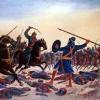Leaderboard
Popular Content
Showing content with the highest reputation on 05/17/2014 in all areas
-
Lets be fair here. The young lady has gone through what none of us would ever like to go through ourselves! The non sikh practice of honour killings. Can anyone say that they wouldnt have some jaded view of a faith BASED on the knowladge and background. So she married a Muslim. She wasnt/isnt a Sikh. You are not born a Sikh but become a Sikh through your actions and yes a family with strong education can help. Instead of pointing out her faults decide to take action against the crippling castist culture that is excused in our community. Campaign for an end to female abortions, educate yourselves so our children have the knowladge and the tools to become great Sikhs. Leave this lady alone.2 points
-
Waheguru Ji Ka Khalsa Waheguru Ji Ki Fateh Guru Roop Sangat Jeo, Below is an attempted translation of Sirdar Kapur Singh Ji's article on the story of Roop Kaur (21st Charitar) as found in Charitropakhyan. In it, Sirdar Sahib aptly refutes the claims of modern scholars that the male protagonist of this Charitar is Sri Guru Gobind Singh Ji himself. It is a tight slap on the faces of all the Gurnindaks out there! A benti in your feet - please do read the whole article, even if you find the translation difficult to read, as im sure we will learn a thing or two from it. You can also download this article for Parchaar purposes from my Scribd account. Ok, read on jeo Dhanvaad! Charitropakhyan - Tale of Roop Kaur Sirdar Kapur Singh Opening verses from Charitro-Pakhyian, scribed by Guru Gobind Singh Ji's personal calligrapher Bhai Nihal Singh (Anandpuri Birr, Page 244) Sirdar Kapur Singh Ji ICS An article under the title ‘Channan Munara’ has been published in February, 1959 edition of ‘Gurmat Parkash’, in which its writer S. Ram Parkash Singh M.A. LLB., Khalsa College, Amritsar has written the following regarding Sri Guru Gobind Singh Ji: ਭਰ ਜੁਆਨੀ ਵਿੱਚ ਇੱਕ ਸੁਨੱਖੀ ਤੇ ਮਾਲਦਾਰ ਮੁਟਿਆਰ ਆਪ ਤੇ ਆਸ.ਕ ਹੋ ਜਾਂਦੀ ਹੈ| ਆਪ ਜੀ ਨੂੰ ਘਰ ਬੁਲਾ ਕੇ ਆਪਣੀ ਜੁਆਨੀ, ਆਪਣੇ ਹੁਸਨ ਤੇ ਆਪਣੇ ਮਾਲ ਦਾ ਜਾਦੂ ਪਾਉਣ ਦਾ ਪੂਰਾ ਯਤਨ ਕਰਦੀ ਹੈ| ਪਰ ਜਦੋ੦ ਆਸ ਪੂਰੀ ਨਹੀ੦ ਹੁੰਦੀ ਤਾਂ ਇੱਕ ਹੋਰ ਬੜਾ ਖਤਰਨਾਕ ਤੀਰ ਛੱਡਦੀ ਹੈ| ਆਪ ਜੀ ਨੂੰ ਸੰਬੋਧਨ ਕਰਕੇ ਆਖਦੀ ਹੈ - ਤੁਸੀ ਮੇਰੀ ਜੁਆਨੀ ਅਤੇ ਮੇਰੇ ਹੁਸਨ ਦਾ ਅਪਮਾਨ ਕਰ ਰਹੇ ਹੋ| ਇੱਕ ਮੁਟਿਆਰ ਹੋਰ ਸਭ ਕੁਝ ਜਰ ਸਕਦੀ ਹੈ, ਪਰ ਹੁਸਨ ਤੇ ਜੁਆਨੀ ਦਾ ਅਪਮਾਨ ਉਸ ਤੋ੦ ਜਰਿਆ ਨਹੀ ਜਾਂਦਾ| ਤੁਸੀ ਜਾਣਦੇ ਹੋਵੋਗੇ ਕਿ ਇਸੇ ਹੀ ਅਪਮਾਨ ਦਾ ਬਦਲਾ ਲੈਣ ਲਈ ਲੂਣਾ ਨੇ ਪੂਰਨ ਭਗਤ ਦਾ ਕੀ ਹਾਲ ਕੀਤਾ ਸੀ| ਲੂਣਾ ਦੀ ਰੂਹ ਇਸ ਵੇਲੇ ਮੇਰੇ ਵਿੱਚ ਪ੍ਰਵੇਸ. ਕਰ ਚੁੱਕੀ ਹੈ|......ਮੈ੦ ਹੁਣੇ ਹੀ ਰੌਲਾ ਪਾਉਣ ਲੱਗੀ ਹਾਂ| ਮੈ੦ ਚੀਕਾਂ ਮਾਰਾਂਗੀ ਤੇ ਕਹਾਂਗੀ ਕਿ ਇਸ........ਗੁਰੂ ਨੇ ਮੈਨੂੰ ਇਕੱਲਾ ਵੇਖ ਕੇ ਮੇਰੀ ਇੱਜ.ਤ ਤੇ ਹੱਥ ਪਾਉਣ ਦਾ ਯਤਨ ਕੀਤਾ ਹੈ|.....ਜੇ ਭਲੀ ਚਾਹੁੰਦੇ ਹੋ ਤਾਂ ਸਮਝੋ ਤੇ ਹੱਠ ਨਾ ਕਰੋ|.....ਆਪਣੀ ਇੱਜ.ਤ ਬਚਾਉ ਤੇ ਮੈਨੂੰ ਤਪਦੀ ਨੂੰ ਠਾਰੋ|.....ਪਰ ਸਤਿਗੁਰੂ ਘਬਰਾਏ ਨਹੀ.....| ਬੋਲੇ ਸਾਧੋ.....ਕਾਮੁ ਕ੍ਰੋਧੁ ਸੰਗਤਿ ਦੁਰਜਨ ਕੀ ਤਾ ਤੇ ਅਹਿਨਿਸਿ ਭਾਗਉ, ਪੰਨਾ 219|.....ਹੁਣ ਮੈ੦ ਜਾਂਦਾ ਹਾਂ| ਇਸ ਤਰ੍ਹਾਂ ਦਸਮ ਪਿਤਾ ਉਸ ਦੇ ਜਾਲ ਚੋ੦ ਅਡੋਲ ਹੀ ਨਿਕਲ ਗਏ| (Translation omitted) The writer is a double graduate Sikh scholar and a law practitioner and fully understands the differences between logic, evidence, eulogy, and varied word-sets. He is a professor at Khalsa College, and as such, cannot be unaware of the life history of Sri Guru Gobind Singh Ji, or of the vast literature available on this topic. The article in question has been published in an SGPC approved magazine, which is recognised as a credible source both by Sikhs and the skeptics. Has the writer wittingly accepted this story, which is nothing more than folklore, to be a historical fact? This folk narrative of ‘Beautiful and rich woman’ Roop kaur is recorded in Triya-Charitar chapter of Sri Dasam Granth that begins with ‘Ath Pakhyaan Likheyate’ (‘ਅਥ ਪਖਯਾਨ ਚਰਿਤ੍ਰ ਲਿਖਯਤੇ’). The meaning of word ‘Opakhyan’ (ਉਪਾਖਯਾਨ) as given in Sanskrit dictionaries is ‘ਵਾਰਤਾ’ and ‘ਵਤ੍ਰ’, which means a secular story, or a fictional story composed to teach certain moral values. From time immemorial, the exegeses of our country’s scriptures have been divided into two categories: Collection of God’s praises (ਪ੍ਰਭੂ ਸੰਹਿਤਾ), and collection of openhearted, friendly advise (ਸੁਹਿਰਦ ਸੰਹਿਤਾ). The Vedas fall into the first category, whereas Puranas are a collection of past events and fictional narratives that are like honest advice of a good friend; their contemplation benefits the readers. Our ancient Granths mention following four branches of knowledge: 1. Logic, Metaphysics, etc., 2. Three Vedas, 3. Secular Arts and Fiction, and 4. Narratives on Politics, Statecraft, etc.. In Sri Dasam Granth, Guru Sahib have written ‘Ath Pakhyaan Charitar Likheyate’ (ਅਥ ਪਖਯਾਨ ਚਰਿਤ੍ਰ ਲਿਖਯਤੇ) in the beginning of Triya-Charitar to make it clear that story of Roop Kaur is a fictitious story; it is a ਸੁਹਿਰਦ ਸੰਹਿਤਾ that has been narrated with the purpose of delivering moral guidance to the society. Guru Ji himself writes in the epilogue of Triya-Charitar: ਸੁਨੈ ਗੁੰਗ ਜੋ ਯਾਹਿ ਸੁ ਰਸਨਾ ਪਾਵਈ ॥ ਸੁਨੈ ਮੂੜ੍ਹ ਚਿਤ ਲਾਇ ਚਤੁਰਤਾ ਆਵਈ ॥ The dumb, who will listen to it, will be blessed with the tongue to speak; the fool, who will listen to it attentively, will get wisdom. The first narrative (Charitar) of Triya-Charitar is about metaphysical reality, where woman and Akaal Purakh are shown to be indistinguishable: ਤੁਹੀ ਖੜਗਧਾਰਾ ਤੁਹੀ ਬਾਢਵਾਰੀ ॥ ਤੁਹੀ ਤੀਰ ਤਰਵਾਰ ਕਾਤੀ ਕਟਾਰੀ ॥ ... You are the straight sword, you are the curved sword; You are the arrow, sword, kaati and kataar … ਤੁਹੀ ਬਿਸਨ ਤੂ ਬ੍ਰਹਮ ਤੂ ਰੁਦ੍ਰ ਰਾਜੈ ॥ ਤੁਹੀ ਬਿਸ੍ਵ ਮਾਤਾ ਸਦਾ ਜੈ ਬਿਰਾਜੈ ॥੨॥ You are ever present in the form of Vishnu, Shiva and mother earth … ਤੁਹੀ ਤੁਰਕ ਹਿੰਦੂ ਜਗਤ ਮੈ ਬਨਾਏ ॥ ਤੁਹੀ ਪੰਥ ਹ੍ਵੈ ਅਵਤਰੀ ਸ੍ਰਿਸਟਿ ਮਾਹੀ ॥ … You have created Turks and Hindus in this world; You have come on earth in form of different paths … First, Guruji describe Akaal Purakh, the ‘Triya’ that is the creator of this universe. Then: ਤੁਹੀ ਜੋਗ ਮਾਯਾ ਤੁਸੀ ਬਾਕਬਾਨੀ ॥ He is also present in the form of Consciousness in human beings; writers, poets and intellectuals take its support to compose literary works. ਤਾਰਨ ਲੋਕ ਉਧਾਰਨ ਭੂਮਹਿ ਦੈਤ ਸੰਘਾਰਨ ਚੰਡਿ ਤੁਹੀ ਹੈ ॥ ਕਾਰਨ ਈਸ ਕਲਾ ਕਮਲਾ ਹਰਿ ਅਦ੍ਰਸੁਤਾ ਜਹ ਦੇਖੇ ਉਹੀ ਹੈ ॥ ਤਾਮਸਤਾ ਮਮਤਾ ਨਮਤਾ ਕਵਿਤਾ ਕਵਿ ਕੇ ਮਨ ਮਧਿ ਗੁਹੀ ਹੈ ॥ Thou art the same Chandika, who ferries across the people; Thou art the redeemer of the earth and destroyer of the demons. Thou art the cause of the Shakti of Shiva, Lakshmi of Vishnu and Parvati, the daughter of Himavan, wherever we see, Thou art there. Thou art Tams, the quality of morbidity, mineness and modesty; Thou art poetry, latent in the mind of the poet. (Chandi Charitar Ukat Bilas) Guru Gobind Singh Ji has described this eternal, ever-prevalent feminine force in the first Charitar of Sri Dasam Granth; it is with this divine force that human beings achieve victory over excesses and injustices: ਮਨ ਤੂੰ ਜੋਤਿ ਸਰੂਪੁ ਹੈ ਆਪਣਾ ਮੂਲੁ ਪਛਾਣੁ ॥ O my mind, you are the embodiment of the Divine Light - recognize your own origin. (Sri Guru Granth Sahib Ji) That’s how the composition that covers almost half of Sri Dasam Granth begins, and further progresses as: ਪ੍ਰਥਮ ਧ੍ਯਾਇ ਸ੍ਰੀ ਭਗਵਤੀ ਬਰਨੌ ਤ੍ਰਿਯਾ ਪ੍ਰਸੰਗ ॥ ਮੋ ਘਟ ਮੈ ਤੁਮ ਹ੍ਵੈ ਨਦੀ ਉਪਜਹੁ ਬਾਕ ਤਰੰਗ ॥੪੬॥ With this sentence, Guruji makes it clear the stories and fables that are to follow are not historic facts; rather, they are only waves of ideas emerging from the mind. Now he begins narrating Triya-Charitars: ਚਿਤ੍ਰਵਤੀ ਨਗਰੀ ਬਿਖੈ ਚਿਤ੍ਰ ਸਿੰਘ ਨ੍ਰਿਪ ਏਕ ॥... ਤਾ ਕੋ ਰੂਪ ਅਨੂਪ ਅਤਿ ਜੋ ਬਿਧਿ ਧਰਿਯੋ ਸੁਧਾਰਿ ॥... ਏਕ ਅਪਸਰਾ ਇੰਦ੍ਰ ਕੇ ਜਾਤ ਸਿੰਗਾਰ ਬਨਾਇ ॥ ਨਿਰਖ ਰਾਇ ਅਟਕਤਿ ਭਈ ਕੰਜ ਭਵਰ ਕੇ ਭਾਇ ॥... ਬਰੀ ਰਾਇ ਸੁਖ ਪਾਇ ਮਨ ਦੁੰਦਭਿ ਢੋਲ ਬਜਾਇ ॥... ਬਹੁਤ ਬਰਸਿ ਸੰਗ ਅਪਸਰਾ ਭੂਪਤਿ ਮਾਨੇ ਭੋਗ ॥ ਬਹੁਰਿ ਅਪਸਰਾ ਇੰਦ੍ਰ ਕੇ ਜਾਤ ਭਈ ਉਡਿ ਲੋਗ ॥ In the state of Chitravarti, there ruled a handsome king named Chitar Singh. A fairy gets bewitched by his beautiful looks and stays with him as his wife for many years. A child is born from this relationship, but one day the fairy decides to leave the earth and goes to heavens, her real home. This fable is one of the earliest literary works in the world’s Granths and is found written in Rigveda (1095) under the names ‘Urvashi and Puroova’. According to the tenth Mandala of Rigveda, when Puroova gets sad and disturbed without Urvashi and decides to end his life, Urvashi descends from the heavens and says this to Puroova: “ਪੁਰੂਰਵਾ, ਮਰਨ ਨਿਸ਼ਚਾ ਤਿਆਗ ਦਿਓ, ਆਤਮਘਾਤ ਨਾ ਕਰੋ, ਨਿਰਦਯੀ ਬਨ ਜੀਵਾਂ ਦੀ ਭੇਟਾ ਆਪਣਾ ਸਰੀਰ ਮਤ ਕਰੋ । ਸ਼ਤ੍ਰਯ ਦੀ ਮਿਤ੍ਰਤਾ ਤਿੰਨ ਕਾਲ ਅਸਥਿਰ ਹੈ, ਕਿਉਂ ਜੁ ਊਹਨ੍ਹਾਂ ਦਾ ਹਿਰਦਾ ਬਿੱਜੂ, ਮੁਰਦਾਖੋਰ ਦਾ ਹੈ ।“ “Puroova, renounce your pledge to die, do not kill yourself, do not be cruel and offer your body to the beasts. Friendship of women is unstable in past, present and future, for their hearts is that of a badger who feeds on dead bodies.” This description and analysis of female character registered in Rigveda, which assigns lower spiritual and social status to women, is the primary source of doctrine and practice imported into later Hindu Shaastars and Granths. Guru Nanak Dev Ji said: ਸੋ ਕਿਉ ਮੰਦਾ ਆਖੀਐ ਜਿਤੁ ਜੰਮਹਿ ਰਾਜਾਨ ॥ So why call her bad? From her, kings are born. With this Tukk, Guruji pointed towards the mentality and situation that took birth from Rigveda and further materialised during past hundreds of centuries. The aim was to criticise and oppose this ideology, which has also been a major cause of weakness in Christian, Jew and Muslim societies for thousands of years; and it is only in the last century or so that the world has gained awareness of its disturbing consequences. In Triya-Charitar of Sri Dasam Granth, lonely Puroova constructs images of the fairy, and orders his ministers to search for someone similar to her: ਤਿਹ ਬਿਨੁ ਭੂਤਤਿ ਦੁਖਿਤ ਹ੍ਵੈ ਮੰਤ੍ਰੀ ਲਏ ਬੁਲਾਇ ॥ ਚਿਤ੍ਰ ਚਿਤ੍ਰਿ ਤਾ ਕੋ ਤੁਰਿਤ ਦੇਸਨ ਦਯੋ ਪਠਾਇ ॥ In their search, the detectives come across the daughter of king of Orissa state who, besides being as pretty as the fairy, possessed more qualities than her: ਖੋਜਤ ਓਡਛ ਨਾਥ ਕੇ ਲਹੀ ਕੰਨਿਕਾ ਏਕ ॥ ਰੂਪ ਸਕਲ ਸਮ ਅਪਸਰਾ ਤਾ ਤੇ ਗੁਨਨ ਬਿਸੇਖ ॥ This sentence merely implies she was more adept in worldly qualities like arts, literature, etc., as her loyalty towards her husband was no better than that of the fairy Urvashi of Rigveda. Anyway, the story written in Sri Dasam Granth goes like this: King Chitar Singh forcibly brings the princess of Orissa back to his Palace. King’s son, Hanwant Singh, was the commanding officer in this battle while Chitar Singh himself did not participate: ਹਨਿਵਤਿ ਸਿੰਘ ਆਗੇ ਕਿਯੋ ਅਮਿਤ ਸੈਨ ਦੈ ਸਾਥ ॥ ਚਿਤ੍ਰ ਸਿੰਘ ਪਾਛੇ ਰਹਿਯੋ ਗਹੈ ਬਰਛਿਯਾ ਹਾਥ ॥ And: ਮਾਰਿ ਓਡਛਾ ਰਾਇ ਕੋ ਲਈ ਸੁਤਾ ਤਿਹ ਜੀਤਿ ॥ ਬਰੀ ਰਾਇ ਸੁਖ ਪਾਇ ਮਨ ਮਾਨਿ ਸਾਸਤ੍ਰ ਕੀ ਰੀਤਿ ॥ To forcibly snatch and marry someone’s daughter is a tradition of Manu Shaastars (ਮਨ ਮਾਨਿ ਸਾਸਤ੍ਰ ਕੀ ਰੀਤਿ). There are eight marriage methods given in Manu Shaastars: 1. Brahman Vivah: To give daughter’s hand by inviting the bride to one’s home. 2. Dev Vivah: To give daughter to those who perform ‘Yagya’. 3. Aaras: To give daughter by taking something in return, like bulls etc. from the groom. A reference against this tradition is mentioned in our Rehitnamas: Dhee Bhen Ka Paisa Layee, Bhaakhat Sikh Hai Soyee. (That Sikh, who takes money for his daughter or sister, is Sikh for namesake only). 4. Prajapatya: A marriage by mutual agreement of boy and girl; commonly known as ‘Love Marriage’ these days, legal term for it is ‘Civil Marriage’. 5. Gaandharv Vivah: To form free relationships wherever and whenever desired; also called ‘Companionate Marriage’; a term propagated by philosopher Bertrand Russell. 6. Aasoor: To swap daughters; it is a tradition that is still practiced in some Indian castes. 7. Raakshas Vivah: To win someone’s daughter as a bounty in war, like our protagonist Chitar Singh; Turk invaders also practiced this with daughters and sisters of our country. As a response, Guru Gobind Singh Ji had strictly forbidden his Singhs from imitating Turk oppressors, for Sikhs have much higher moral standards: ਹਮ ਲੋ ਜਾਨੋ ਪੰਥ ਉਚੇਰੇ ।। ਨਹੀ ਅਧੋਗਤਿ ਬਿਖੈ ਪੁਚਾਵੈਂ । 8. Peshaach Vivah: To forcibly snatch weeping and crying girl, like Sri Krishan snatched Rukmani while she was worshipping, and like thousands of girls who were forcibly picked up during partition of 1947. These eight methods of marriage are the tradition of the Shaastars, thus Chitar Singh married Chitarmati, the princess of Orissa, without any worries. Although Chitarmati became Chitar Singh’s wife, it does not imply she also became loyal to her husband: ਹਨਿਵਤਿ ਸਿੰਘਹਿ ਸੋ ਰਹੈ ਚਿਤਵਤ ਆਠੋ ਜਾਮ ॥ In her heart, she would always keep thinking about her stepson. One day, she makes some excuse to bring him close to herself: ਚੋਰ ਚਤੁਰਿ ਚਿਤ ਲਯੋ ਕਹੋ ਕਸ ਕੀਜੀਐ ॥ ... ਅਤਿ ਅਨੂਪ ਸੁੰਦਰ ਸਰਸ ਮਨੋ ਮੈਨ ਕੇ ਐਨ ॥ ਮੋ ਮਨ ਕੋ ਮੋਹਤ ਸਦਾ ਮਿਤ੍ਰ ਤਿਹਾਰੇ ਨੈਨ ॥ O prince! Your eyes are extraordinarily beautiful; they are like Meneka’s eyes, they mesmerise me. Princess Chitarmati sings a lot of similar praises for her stepson prince, but: ਵਾ ਕੀ ਕਹੀ ਨ ਨ੍ਰਿਪ ਸੁਤ ਮਾਨੀ ॥ ਚਿਤ੍ਰਮਤੀ ਤਬ ਭਈ ਖਿਸਾਨੀ ॥ When the prince pays no heed to her, she feels her beauty and youthfulness is insulted; and: ਚਿਤ੍ਰ ਸਿੰਘ ਪੈ ਜਾਇ ਪੁਕਾਰੋ ॥ ਬਡੋ ਦੁਸਟ ਇਹ ਪੁਤ੍ਰ ਤੁਹਾਰੋ ॥ ਫਾਰਿ ਚੀਰ ਕਰ ਆਪਨੇ ਮੁਖ ਨਖ ਘਾਇ ਲਗਾਇ ॥ ਰਾਜਾ ਕੋ ਰੋਖਿਤ ਕਿਯੌ ਤਨ ਕੋ ਚਿਹਨ ਦਿਖਾਇ ॥ She rips her clothes, scratches her face with her own nails, and complains to her husband that his son is evil: ਬਚਨ ਸੁਨਤ ਕ੍ਰੁਧਿਤ ਨ੍ਰਿਪ ਭਯੋ ॥ ਮਾਰਨ ਹੇਤ ਸੁਤਹਿ ਲੈ ਗਯੋ ॥ ਮੰਤ੍ਰਿਨ ਆਨਿ ਰਾਵ ਸਮੁਝਾਯੋ ॥ ਤ੍ਰਿਯਾ ਚਰਿਤ੍ਰ ਨ ਕਿਨਹੂੰ ਪਾਯੋ ॥ The king orders the slaying of his son, but his ministers advise him against the decision by saying, O King, character of women is not easy to understand, do not fall for such tricks so easily: ਇਤਿ ਸ੍ਰੀ ਚਰਿਤ੍ਰ ਪਖ੍ਯਾਨੇ ਤ੍ਰਿਯਾ ਚਰਿਤ੍ਰੇ ਮੰਤ੍ਰੀ ਭੂਪ ਸੰਬਾਦੇ ਦੁਤਿਯ ਚਰਿਤ੍ਰ ਸਮਾਪਤਮ ਸਤੁ ਸੁਭਮ ਸਤੁ ॥ This is the second chapter of Sri Dasam Granth’s Triya Charitar section. All the stories that follow in this section are ‘ਮੰਤ੍ਰੀ ਭੂਪ ਸੰਬਾਦੇ’ i.e. they are fictional dialogues exchanged between King Chitar Singh and his minister and have no historical basis to them. Two things worth mentioning at this point: The topic of relationship between mother and son is as old as the mountains. It is the main motif behind the ancient Greek story of Oedipus, which was later used by the famous psychologist Sigmund Freud to name Oedipus complex. This narrative is found in summary form at a few other places also. However, in the Indian society and folklore, this psychological problem is depicted in the form of illicit feelings of the stepmother towards her youthful stepson. At least this is the summary of many folktales and also of Triya-Charitar’s main story, from which remaining 400 or so stories emerge. Researchers consider Oedipus complex as the base of their psychoanalysis to attempt to describe and illustrate human behaviour. The mysterious way in which the writer of Triya-Charitar uses the story of Hanwant Singh and Chitarmati as a foundation to capture other 400 stories under this bracket appears highly intricate. By the way, it is an old literary technique to use one story as a base and to weave other stories around it. A Dr. Keith mentions that the literary importance of Pandit Gunadaye’s composition, the now untraceable Braht Katha, was in no way less than Mahabharat or Ramayana. Granths like Kashemender’s Bhram Katha Manjari (1063-66 A.D.) and Somdev’s Katha Sarit Saagar (1081 A.D.) are small derivatives of Braht Katha. Dr. Keith says the composition had seven lakh Sloks, in which the writer first constructed a major plot and then kept weaving many more stories around that plot. The same technique has been extensively used in Katha Sarit Saagar’s Vaitaal Panch Visti and Vishnu Sharma’s Panch Tantra. Moreover, the Arabic writers also borrowed this technique to compose books like the Alif Laila, etc.. However, the above mentioned psychological mystery of Sri Dasam Granth’s Triya-Charitar cannot be found elsewhere. The second important thing to mention here is that this story of illicit relationship between mother and son has been narrated in many languages, like Oriya and Tamil, for instance. In Punjabi, this story is clearly mentioned in the story of Pooran Bhagat: ਅਲਫ, ਆਖ ਸਖੀ, ਸਿਆਲਕੋਟ ਅੰਦਰ, ਪੂਰਨ ਪੁੱਤ ਸਲਵਾਨ ਦੇ ਜਾਇਆ ਏ ।। A third thing worth mentioning: Because of lack of understanding of our folk-literature and Granths, many scholars and laymen have fallen prey to the dangerous misunderstanding that the story of Roop Kaur as described in Triya-Charitar is a part of Guru Gobind Singh Ji’s own history. The reason behind this shall be explained a little later when we dissect Roop Kaur’s story. Anyway, the story progresses like this: After the minister of Chitar Singh had finished narrating 20 Triya-Charitars to him: ਰੀਝ ਰਾਇ ਐਸੇ ਕਹ੍ਯੋ ਬਚਨ ਮੰਤ੍ਰਿਯਨ ਸੰਗ ॥ ਪੁਰਖ ਤ੍ਰਿਯਨ ਚਤੁਰਨ ਚਰਿਤ ਮੋ ਸੋ ਕਰਹੁ ਪ੍ਰਸੰਗ ॥ The king said - Now narrate to me a story in which man plays Charitar on a woman. It is now that his minister narrates to him a story of man cleverly tricking the woman in the 21st and 22nd Charitars, and ends this story in 23rd Charitar with ਇਤਿ ਸ੍ਰੀ ਚਰਿਤ੍ਰ ਪਖ੍ਯਾਨੇ ਤ੍ਰਿਯਾ ਚਰਿਤ੍ਰੇ ਮੰਤ੍ਰੀ ਭੂਪ ਸੰਬਾਦੇ... । The story mentioned in the 21st, 22nd and 23rd Charitars is the story of Roop Kaur. Those unaware of various literary styles mis-interpret it to be Guru Gobind Singh Ji’s own story, and chose to blatantly ignore ‘Charitar Pakhyane Mantri Bhoop Sambaade’ (The Charitar as narrated by Minister Bhoop) written at the end of each Charitar. A clear blasphemy takes place against Guru Ji if we consider him to be the protagonist of these three stories. However, the character of Guruji that emerges out of this ill-belief is neither inspiring nor he resembles Guru Ji’s real character. Then why do some ‘Sikhs’ consider these three stories to be part of Guru Gobind Singh Ji’s life history, and why do scholars like Ram Parkash Singh also choose to believe in this dangerous and gross misunderstanding? We have discussed two reasons for this earlier: 1. Triya-Charitar is a Secular fiction: It is a bearer of our great historical and literary past, and as such, is self-composed but is certainly not an original piece of writing. Its stories and composition material has been borrowed from thousands of years old folk literature, folk narratives and Granths. 2. Like its content, the literary form of Triya-Charitars is also borrowed from traditional sources. It is because of lack of understanding of the above mentioned points that people wrongly believe Guru Ji’s compositions can only be Gurbani or Gurvaak and not plain work of secular fiction. There is also a third reason, which incidentally is related to literary techniques, that has solidified this dangerous misunderstanding. That reason is the writer’s craft of adding local colours to his composition. It is the ultimate aim of artist of any medium to create illusion of reality with his creation. The more effective he is in spinning this web of illusion, the better the chances of his art and creation being successful. Guru Gobind Singh Ji were not only Guru Avtar, all-capable Mukti Guide, and Gurbani’s Prophet, he was also a great artist and revolutionary intellectual. He knew the true goal of realism lies in creating Maya-Charitars that could create an unparalleled illusion of actual facts. That’s why Guru Ji has said this about talent of good artists: ਤੁਹੀ ਜੋਗ ਮਾਯਾ ਤੁਸੀ ਬਾਕਬਾਨੀ ॥. To achieve this desire of adding unmatched realism, artists add local and historic colours to their works. In the verse from Kaadarghaar’s Sehraafi: ਅਲਫ, ਆਖ ਸਖੀ, ਸਿਆਲਕੋਟ ਅੰਦਰ, ਪੂਰਨ ਪੁੱਤ ਸਲਵਾਨ ਦੇ ਜਾਇਆ ਏ ।। The poet has added local, factual and historic colours by mentioning Sialokot and characters Pooran and Salvaan in his composition. Sialkot is a famous town in Punjab and Sehraafi was written in Punjabi language, and for the Punjabis. This is how the poet has set the world famous ancient folklore of immoral mother-son relationship against local background. The name Pooran is a factual colour because it is a common Punjabi name. Similarly, King Salvaan is mentioned in Indian history, but Sialkot was neither his Capital, nor his place of residence. It was merely his administrative centre, like Maharaja Ranjit Singh had Peshawar as his administrative centre. The only intention of the poet was to add historical dimension to this world-famous tale, so that it could appear vivid and real to the local readers. However, to claim that King Salvaan, on whose name ‘Saaka’ calendar was started about 1880 years ago and who had Pratashthaan (South India) as his capital, actually lived in Sialkot and had married a Chamari named Loona would be a grave mistake, and would also prove the lack of knowledge of the person making such ignorant derivations. Therefore, this is the actual reason why people like Ram Parkash and other ‘scholars’ find themselves trapped in the gross misconception that story of Roop Kaur is a historical fact, and not an imaginary story. They make the mistake of interpreting this literary technique as a factual narrative. In Charitars 21st, 22nd, and 23rd, Guru Gobind Singh Ji have used this literary technique in an innovative way, hence it is not surprising that the common man often misinterprets the meaning behind it. That is why Guru Ji has said about this composition: ਸੁਨੈ ਮੂੜ੍ਹ ਚਿਤ ਲਾਇ ਚਤੁਰਤਾ ਆਵਈ ॥, i.e., the secrets will unfold if the story is read with concentration, which will also sharpen the wits of the reader. ਤੀਰ ਸਤੁਦ੍ਰਵ ਕੇ ਹੁਤੋ ਪੁਰ ਅਨੰਦ ਇਕ ਗਾਉ ॥ ਨੇਤ੍ਰ ਤੁੰਗ ਕੇ ਢਿਗ ਬਸਤ ਕਹਲੂਰ ਕੇ ਠਾਉ ॥੩॥ On the banks of river Sutlej and near the mountain of Naina Devi, there exists a village called Anandpur in the state of Kahloor. This village is the one that Guru Gobind Singh Ji had established after the battle of Bhangani. ਕਾਹਲੂਰ ਮੈਂ ਬਾਂਧਿਯੋ ਆਨ ਆਨੰਦਪੁਰ ਗਾਂਵ ॥ When the writer of Triya-Charitar is about to narrate an incident that took place in such a famous town, which reader or listener can possibly ignore paying attention to the story? This is exactly the aim of the writer – to pull the attention of the reader towards the story, and he has been successful in doing so. However, the story that follows has got no direct or indirect relation with Anandpur town, the birthplace of the Khalsa. ਏਕ ਤ੍ਰਿਯਾ ਧਨਵੰਤ ਕੀ ਤੌਨ ਨਗਰ ਮੈ ਆਨਿ ॥ ਹੇਰਿ ਰਾਇ ਪੀੜਤ ਭਈ ਬਿਧੀ ਬਿਰਹ ਕੇ ਬਾਨ ॥ According to the story, some rich man’s wife, who could not accompany her for some reason, comes to Anandpur and gets infatuated by its ruler and gets desperate for his companionship. The woman, whose name was Roop Kaur, orders her servants to bring the king to her place on some pretext or the other - ਨਗਰ ਰਾਇ ਤੁਮਰੋ ਬਸਤ ਤਾਹਿ ਮਿਲਾਵਹੁ ਮੋਹਿ ॥. Her servants say to the King, come with us if you want to obtain the Mantar that you have been after. How can this King be our Guru Ji, for Guru-Ghar tradition clearly says: ਤੰਤੁ ਮੰਤੁ ਪਾਖੰਡੁ ਨ ਜਾਣਾ ਰਾਮੁ ਰਿਦੈ ਮਨੁ ਮਾਨਿਆ ।। I know nothing of Tantric spells, magical mantras and hypocritical rituals; enshrining the Lord within my heart, my mind is satisfied. Carrying on with the story, this king disguises himself as a Saadhu and reaches Roop Kaur’s Dera. Seeing her desire getting fulfilled before her eyes, she dresses up in nice clothes, and offers flowers, betel-leaf (paan), alcohol etc. in his service: ਫੂਲ ਪਾਨ ਅਰੁ ਕੈਫ ਮੰਗਾਯੋ ॥ ਆਗੇ ਟਰਿ ਤਾ ਕੋ ਤਿਨ ਲੀਨਾ ॥ In regards to chewing of betel-leaf, Guru Ji’s hukam is: ਸਿੱਖ ਹੋਇ ਪਾਨ ਖਾਏ, ਸੋ ਭੀ ਤਨਖਾਈਆ, i.e., Any Sikh who chews betel-leaf is an apostate. But the protagonist of this story goes a few steps further than that, and consumes paan and opium-mixed wine too. ਤਬ ਤਾ ਸੋ ਤ੍ਰਿਯ ਯੌ ਕਹੀ ਭੋਗ ਕਰਹੁ ਮੁਹਿ ਸਾਥ ॥ Then the woman said, form physical relation with me. What else could the woman say to a man who has consumed opium, and is chewing paan lying on the bed? The king is baffled, and thinks to himself: ਮੰਤ੍ਰ ਲੈਨ ਆਯੋ ਹੁਤੋ ਭਈ ਔਰ ਕੀ ਔਰ ॥ I had come here to obtain the Mantar, but it has turned into something else altogether. Then a question and answer session takes places between the Saadhu (the king) and the woman: Question: ਕਹਿਯੋ ਤੁਮਾਰੋ ਮਾਨਿ ਭੋਗ ਤੋਸੋ ਨਹਿ ਕਰਿਹੋ ॥..ਧਰਮਰਾਜ ਕੀ ਸਭਾ ਠੌਰ ਕੈਸੇ ਕਰਿ ਪਾਊ ॥ I will not form physical relations with you... how would I find place in Dharam Raaj’s court if I agreed? Answer: ਕਾਮਾਤੁਰ ਹ੍ਵੈ ਜੋ ਤ੍ਰਿਯਾ ਆਵਤ ਨਰ ਕੇ ਪਾਸ ॥ ਮਹਾ ਨਰਕ ਸੋ ਡਾਰਿਯੈ ਦੈ ਜੋ ਜਾਨ ਨਿਰਾਸ ॥ If a kaam-ridden woman comes to a man and he refuses her; he should be thrown in the depths of hell. Question: ਪਾਇ ਪਰਤ ਮੋਰੋ ਸਦਾ ਪੂਜ ਕਹਤ ਹੈ ਮੋਹਿ ॥ ਤਾ ਸੋ ਰੀਝ ਰਮ੍ਯੋ ਚਹਤ ਲਾਜ ਨ ਆਵਤ ਤੋਹਿ ॥ People fall at my feet and worship me; and you want me to have physical relations with you, are you not ashamed of yourself? Answer: ਕ੍ਰਿਸਨ ਪੂਜ ਜਗ ਕੇ ਭਏ ਕੀਨੀ ਰਾਸਿ ਬਨਾਇ ॥ ਭੋਗ ਰਾਧਿਕਾ ਸੋ ਕਰੇ ਪਰੇ ਨਰਕ ਨਹਿ ਜਾਇ ॥ Krishna was also worshipped by everyone, but he did perform Raas-Leela; He had physical relations with Radhika, but he did not go to hell? In short, the woman leaves the Saadhu looking up and down for answers by saying: ਪੰਚ ਤਤ ਲੈ ਬ੍ਰਹਮ ਕਰ ਕੀਨੀ ਨਰ ਕੀ ਦੇਹ ॥ ਕੀਯਾ ਆਪ ਹੀ ਤਿਨ ਬਿਖੈ ਇਸਤ੍ਰੀ ਪੁਰਖ ਸਨੇਹ ॥ With five elements, Brahm created the man’s body; and it is Him only who has created the love between male and female. Can the great emancipator, the bright-as-the-sun, the invincible Guru Gobind Singh Ji, be defeated by such small, petty argument? It is something worth thinking. Seeing the king in confusion, Roop Kaur fires another shot: ਆਜੁ ਹਮਾਰੇ ਸਾਥ ਮਿਤ੍ਰ ਰੁਚਿ ਸੌ ਰਤਿ ਕਰਿਯੈ ॥ ਹੋ ਨਾਤਰ ਛਾਡੌ ਟਾਂਗ ਤਰੇ ਅਬਿ ਹੋਇ ਨਿਕਰਿਯੈ ॥ Either form physical relation with me, or accept that you are not man enough and sneak away from under my legs. On hearing this challenge, the king thinks: ਰਾਇ ਚਿਤ ਇਹ ਭਾਤਿ ਬਿਚਾਰੋ ॥ ਇਹਾ ਸਿਖ ਕੋਊ ਨ ਹਮਾਰੋ ॥ ... ਕਵਨ ਸਿਖ੍ਯ ਮੁਹਿ ਆਨਿ ਉਬਾਰੈ ॥ There is no Sikh here that could come and save me... Could these words be that of Guru Gobind Singh Ji, in whose praise the following has been written: ਜਾਹਿ ਸੰਗ੍ਰਾਮ ਬਾਰਤਾ ਹੋਇ, ਸਸ਼ਤ੍ਰ ਪ੍ਰਹਾਰਨ ਕਰਹਿ ਬਖਾਨ ।। ਤਹ ਪ੍ਰਥਮ ਗਿਨਤੀ ਮਹਿ ਸਗਰੇ ਕਲਗੀਧਰ ਕੋ ਗਿਨਹ ਮਹਾਨ ।। In the battlefield, He lets his weapons do the talking, That is why Kalgidhar Ji is counted as the greatest of them all. Why don’t naïve Sikhs analyse the story in this context? They get stumped by the word ‘Sikh’ and think it is used only for Guru’s Sikhs. The word ‘Sikh’ here has been used for a servant or employee, and is used in the same context later in the story also, where: ਚੋਰ ਚੋਰ ਕਹਿ ਕੈ ਉਠੀ ਸਿਖ੍ਯਨ ਦਿਯੋ ਜਗਾਇ ॥ Screaming ‘thief! Thief!’ (Roop Kaur) woke up her sikhs. The word ‘Sikh’ also has the same meaning (servant, employee) in KabyoBaach Benti Chaupai, the literary portion of Triya-Charitar, where Guru Ji says: ਸੁਖੀ ਬਸੈ ਮੋਰੋ ਪਰਿਵਾਰਾ ॥ ਸੇਵਕ ਸਿੱਖਯ ਸਭੈ ਕਰਤਾਰਾ ॥ May my family live in comfort and ease along with all my servants. ‘Sikh’ here does not refer to the followers of Sikh faith; rather it is used for servants and other sewadars. It is because of subtleties like these, Guru Sahib has said: ਸੁਨੈ ਮੂੜ੍ਹ ਚਿਤ ਲਾਇ ਚਤੁਰਤਾ ਆਵਈ ॥ The fool, who will listen to it attentively, will get wisdom. Therefore, ignorance will create disgust instead of wisdom if a great literary Granth like Triya-Charitar is not read and analysed carefully. The writer of Triya-Charitar has purposefully used the plural form of ‘Sikh’; so that support could be given to the illusion weaved at the beginning of the story where Anandpur is mentioned. There was a great need for using this method at this important juncture of the story, because it shakes and wakes up even the simplest of readers, and makes him realise that an imposter, tobacco-alcohol consuming king of Anandpur, who gets tricked by a loose woman simply cannot be their Guru. However, it is imperative for the writer to keep the literary illusion intact until the end, so that the seeds of consciousness and moral cleansing that he wants to sow in the reader’s mind can germinate. Aristotle calls it Catharsis and is the utopian aim of every art form. Coming back to the story, Roop Kaur launches a final attack on the king: ਅਬ ਹੀ ਚੋਰਿ ਚੋਰਿ ਕਹਿ ਉਠਿਹੌ ॥ ਤੁਹਿ ਕੋਪ ਕਰਿ ਮਾਰਿ ਹੀ ਸੁਟਿਹੌ ॥ She said, now I will scream ‘Thief, Thief’; people will then kill (you) in rage. She screams and wakes up her sikhs in the Dera, and the king runs off leaving his shoes behind. The 21st Charitar ends here, and in the 22nd Charitar: ਚੋਰ ਬਚਨ ਸਭ ਹੀ ਸੁਨਿ ਧਾਏ ॥ ਕਾਢੇ ਖੜਗ ਰਾਇ ਪ੍ਰਤਿ ਆਏ ॥ ... ਆਗੇ ਪਾਛੇ ਦਾਹਨੇ ਘੇਰਿ ਦਸੋ ਦਿਸ ਲੀਨ ॥ ... ਲਾਤ ਮੁਸਟ ਬਾਜਨ ਲਗੀ ਸਿਖ੍ਯ ਪਹੁੰਚੇ ਆਇ ॥ ਭ੍ਰਾਤ ਭ੍ਰਾਤ ਤ੍ਰਿਯ ਕਹਿ ਰਹੀ ਕੋਊ ਨ ਸਕਿਯੋ ਛੁਰਾਇ ॥ Although the king was able to escape in the commotion that ensued, Roop Kaur’s brother gets mistaken for the thief; and people thrash him up and put him behind bars. That’s the end of the 22nd Charitar. We have pointed out the reasons why simpletons make the mistake of treating these stories as the writer’s own life story: First is the local colour of Anandpur and second, the use of word ‘Sikh’ for servants and caretakers. There is a third reason in the 22nd Charitar, which has solidified this literary illusion even further. In the 22nd Charitar, the Gurvaak is recorded in the form of Question and Answer session between Roop Kaur and the king. Some faithful and sincere Jathedar of Sri Akal Takht Sahib had these words etched on the upper Mehrab of the lower staircase, which pilgrims and other Sikhs would read every day. These words are: ਸੁਧਿ ਜਬ ਤੇ ਹਮ ਧਰੀ ਬਚਨ ਗੁਰ ਦਏ ਹਮਾਰੇ ॥ ਪੂਤ ਇਹੈ ਪ੍ਰਨ ਤੋਹਿ ਪ੍ਰਾਨ ਜਬ ਲਗ ਘਟ ਥਾਰੇ ॥ ਨਿਜ ਨਾਰੀ ਕੇ ਸਾਥ ਨੇਹੁ ਤੁਮ ਨਿਤ ਬਢੈਯਹੁ ॥ ਪਰ ਨਾਰੀ ਕੀ ਸੇਜ ਭੂਲਿ ਸੁਪਨੇ ਹੂੰ ਨ ਜੈਯਹੁ ॥ ਬਾਲ ਹਮਾਰੇ ਪਾਸ ਦੇਸ ਦੇਸਨ ਤ੍ਰਿਯ ਆਵਹਿ ॥ ਮਨ ਬਾਛਤ ਬਰ ਮਾਗਿ ਜਾਨਿ ਗੁਰ ਸੀਸ ਝੁਕਾਵਹਿ ॥ ਸਿਖ੍ਯ ਪੁਤ੍ਰ ਤ੍ਰਿਯ ਸੁਤਾ ਜਾਨਿ ਅਪਨੇ ਚਿਤ ਧਰਿਯੈ ॥ ਹੋ ਕਹੁ ਸੁੰਦਰਿ ਤਿਹ ਸਾਥ ਗਵਨ ਕੈਸੇ ਕਰਿ ਕਰਿਯੈ ॥ Ever since I came of age, my Guru has taught me Son, for as long as you have breaths in your body, keep developing love with your own wife, but never even dream of going to someone’s else bed. O woman! Women from every corner come to me, to get their wishes fulfilled, they bow their heads in respect. The Sikhs are my sons, their wives my daughters, O woman! Tell me how is it possible for me to form physical relations with them? This verse (Chhand) of Triya-Charitar is, without a doubt, factual. It is a historical fact that Guru Tegh Bahadur Ji gave the above advice to his son Guru Gobind Singh Ji, which the writer of Triya-Charitar later kneaded into 21st Charitar. However, those who infer the story in 22nd Charitar is a historical narrative based on the factuality of the above Chhand show that they are ignorant of different literary techniques. Alif Laila, an 8th Century’s Arabic composition; 11th Century Sanskrit work Katha Sarit Saagar; and Bustaan, a famous Persian book of the 13th Century are some examples that make use of this literary technique. In these works, words written by other poets have been assigned to story’s characters, with the intention of expanding a certain plot within that story. For example, portions of Quran Sharif’s verses are used at various places writer Waris Shah in his composition Heer. Nobody has ever misinterpreted these verses to be life events of Prophet Mohammed, unlike our so-called scholars like Prof. Ram Parkash and others. In fact, Waris Shah claims that he has expanded on the meanings of Quran’s verses by using them in love story of Heer and Ranjha by saying: ਇਹ ਕੁਰਾਨ ਸ਼ਰੀਫ ਦੇ ਮਾਇਨੇ ਨੇ ਜਿਹੜੇ ਸਿਅਰ ਮੀਆਂ ਵਾਰਸ ਸਾਹ ਦੇ ਨੇ । These are the meanings of Quran Sharif, as given by Poet Waris Shah. And this is exactly how the kneading of Gurvaak Chhand of 22nd Charitar should be interpreted. ‘DURGA PARBODH’ (1899): BY GYANI DITT SINGH JI, REVOLUTIONARY LEADER OF SINGH SABHA MOVEMENT “BURAYI DA TAKRA” (1949): BY PROF. SAHIB SINGH JI, PANTHIC SCHOLAR AND FAMOUS TEEKAKAR OF SRI GURU GRANTH SAHIB JI ਦਸਮਗ੍ਰੰਥ ਵਿਚ ਇਸਤਰੀ ਪੁਰਖਾਂ ਦੇ ਛਲ ਕਪਟ ਭਰੇ ਪ੍ਰਸੰਗ ਜਿਸ ਭਾਗ ਵਿਚ ਹਨ, ਉਸ ਦੀ “ਚਰਿਤ੍ਰੋਪਾਖਯਾਨ” ਸੰਗਯਾ ਹੈ, ਪਰ ਪ੍ਰਸਿਧ ਨਾਮ “ਚਰਿਤ੍ਰ” ਹੀ ਹੈ... ਇਸ ਤੋਂ ਇਹ ਸਿੱਟਾ ਨਹੀਂ ਚਾਹੀਏ ਕਿ ਆਪਣੀ ਧਰਮਪਤਨੀ ਅਤੇ ਯੋਗਯ ਇਸਤ੍ਰੀਆਂ ਤੇ ਵਿਸ਼ਵਾਸ ਕਰਨਾ ਅਯੋਗ ਹੈ, ਭਾਵ ਇਹ ਹੈ ਕਿ ਕਾਮਤੁਰ ਹੋ ਕੇ ਪਰਇਸਤ੍ਰੀਆਂ ਦੇ ਪੇਚ ਫਸਕੇ ਲੋਕ ਪਰਲੋਕ ਖੋ ਲੈਣਾ ਕੁਕਰਮ ਹੈ । MAHANKOSH (1930): BY PANTH RATTAN BHAI KAHN SINGH JI ‘NABHA’1 point
-
There are 2 amritdhari Sikh candidates in the up and coming European parliamentary elections on may 22nd. The national liberal party is a pro self-determination that wants freedom for all stateless nations like punjab/khalistan, kashmir, tamil elaam, kurdistan, tibet, etc,etc I am strongly thinking of voting for this party as all the other parties have done nothing for British Sikhs and Sikh votes go to waste when they vote for other parties. I think its time we as a collective community use vote bank politics and vote for this party to ensure Sikhs have a voice in British and European affairs. There is there website address: http://www.nationalliberal.org1 point
-
For what reason should she feel ashamed? She married a non-Sikh, but did she ever know anything about Sikhi? No? So why are we angry at her? Not everyone has the luxury of being taught about Sikhi growing up. You guys need to consider this. They do not consider themselves Sikhs to begin with, they are just normal people, and so marrying any other person is perfectly acceptable. Why are we blaming her for that? Imagine girls reading these posts. Men being quite nasty about a sister they know very little about. What would they think about Singhs? And about Sikhi? The problem is the lack of education or whatever else, and it will NOT get anywhere near to being fixed through judgement and slander. Endlessly blaming girls rather than understanding and isolating the problems is more ignorant.1 point
-
Body is a reflection of what's going in the mind. Sikhi is an opportunity to create a unique expression of the divine. Unfortunately its become an obligation. The current decisions in most Sikhs are coming out of fear rather than a place of love for their path. One can only hope that their youth years are truth gathering years and once they will realize what a blessing Sikhi is they will embrace it whole heartedly.1 point
-
If these tombs are historically validated and declared authentic, than Islamic bodies should set up entities to care for them in the Punjab. Secondly if this is attributed to religious sentiments, then from my understanding Islamic decries grave worship. So such an uproar does not make any sense. I would say the RSS is not behind this (if it is behind anything at all) but some local miscreants caught up in the tide of fanaticism sweeping India. BJP has won the elections, and a certain portion of Muslims empathise with their brethren in neighbouring Pakistan. Maybe this is an amateur attempt at vengeance against Sikhs, who have continually preserved Indian statehood during military combat? Matters will probably be more aggravated by blaming Hindus who probably have nothing to do with this.1 point
-
1 point
-
1 point
-
While we are busy debating and dissing each other over trivial issues, our enemies are yet at it again desecrating our religious symbols and killing our people. I said this months back and I repeat, when Sikhs are about to be killed by dushts they are not asked whether they eat meat, believe in Kes or Keski as Kakkar... They are killed because they are SIKHS. Then why can't we unite as Sikhs instead of dividing ourselves? Now this might be a political ploy too, remember it is during the election period where parties can do anything to malign the other side.1 point
-
We in our family do paath ourselves , if necessary , wherever family members reside (we are all doing Jobs ) ,local sangat joins to help in case of need opting for daytime rauls , the night duties are taken by family members voluntarily . If necessary no is not present , we go for sehaj path , continuing recitation 8-12 hrs daily and performing samapti bhog on fixed date .This way , we get to recite and listen baani and able to understand and imbibe the values taught by Guru Sahib ji in gurbaani . We do not wish to take pride in it , just we are doing what has been taught by our great parents and the MAha purushs we came across in our life , we are just following the way of Life shown by them . REquest sangat to undertake the recitationn of Gurbanii themselves (as far as possible ) or take paathis from reliable pool guaranteeing the life of the paathi singhs , and above all please spare time to listen also , otherwise there is no use of performimg paaths1 point
-
No just hinduvta. a jew vs zionist like thing. ਖਾਲਿਸਤਾਨ ਜ਼ਿੰਦਾਬਾਦ | ਵਾਹਿਗੁਰੂ ਜੀ ਕਾ ਖਾਲਸਾ | ਵਾਹਿਗੁਰੂ ਜੀ ਕੀ ਫਤਹਿ | |1 point
-
In a forest, a pregnant deer is about to give birth. She finds a remote grass field near a strong-flowing river. This seems a safe place. Suddenly labour pains begin. At the same moment, dark clouds gather around above & lightning starts a forest fire. She looks to her left & sees a hunter with his bow extended pointing at her. To her right, she spots a hungry lion approaching her. What can the pregnant deer do? She is in labour! What will happen? Will the deer survive? Will she give birth to a fawn? Will the fawn survive? Or will everything be burnt by the forest fire? Will she perish to the hunters' arrow? Will she die a horrible death at the hands of the hungry lion approaching her? She is constrained by the fire on the one side & the flowing river on the other & boxed in by her natural predators. What does she do? She focuses on giving birth to a new life. The sequence of events that follows are: - Lightning strikes & blinds the hunter. - He releases the arrow which zips past the deer & strikes the hungry lion. - It starts to rain heavily, & the forest fire is slowly doused by the rain. - The deer gives birth to a healthy fawn. In our life too, there are moments of choice when we are confronted on αll sides with negative thoughts and possibilities. Some thoughts are so powerful that they overcome us & overwhelm us. Maybe we can learn from the deer. The priority of the deer, in that given moment, was simply to give birth to a baby. The rest was not in her hands & any action or reaction that changed her focus would have likely resulted in death or disaster. Ask yourself, Where is your focus? Where is your faith and hope? In the midst of any storm, do keep it on God always. He will never ever dissapoint you. NEVER. Remember, He neither slumbers nor sleep...1 point
-
Very much agree, a lot of older Sikhs find him to be a "terrorist" because when they were young they were tuned to Indian media portraying Sant ji and the Shaheeds as terrorists and killing Hindus etc..... Sikh youth today should be inspired by his motive to fight injustice as the Sikhs were being treated as slaves back then and still now. A lot of Sikhs don't know the real truth behind 1984. All it takes is some research and reading "A Gallant Defender" can easily see what really happened. I guarantee this guy you talked with was probably following up Indian propaganda and didn't understand fully what happened in Punjab in the 70's and 80's.1 point
-
Here is a beautiful Amrit Vela Simran recording of Veer Manpreet Singh from 9th March 2013. Simply divine stuff... http://soundcloud.com/satwant8/20130309-veer-manpreet-singh and some other live kirtan recordings http://soundcloud.com/satwant2/20130127-veer-manpreet-singh http://soundcloud.com/satwant2/20130210-veer-manpreet-singh http://soundcloud.com/satwant3/20130217-veer-manpreet-singh http://soundcloud.com/satwant5/20130316-veer-manpreet-singh http://soundcloud.com/satwant6/20130317-veer-manpreet-singh http://soundcloud.com/satwant7/20130324-veer-manpreet-singh1 point
-
Brilliant work. Very interesting statement: I wonder how this would sit with those who claim all of DG is Gurbani? I've always thought the DG was produced to expand Sikhs minds in matters of a diverse nature.1 point
-
1 point











